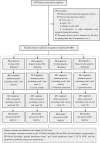Electroacupuncture and carbamazepine for patients with trigeminal neuralgia: a randomized, controlled, 2 × 2 factorial trial
- PMID: 38816482
- PMCID: PMC11319385
- DOI: 10.1007/s00415-024-12433-x
Electroacupuncture and carbamazepine for patients with trigeminal neuralgia: a randomized, controlled, 2 × 2 factorial trial
Abstract
Background: Trigeminal neuralgia (TN) is difficult to treat due to its severe pain intensity and recurring episodes, which significantly impact quality of life.
Objectives: We aimed to assess the effectiveness of electroacupuncture (EA) in alleviating the pain intensity in TN, and to determine whether EA combined with low-dosage carbamazepine (CBZ) has a synergistic effect.
Methods: A multi-centre, randomized, 2 × 2 factorial trial was conducted. Participants who met the inclusion criteria received active EA or sham EA for 60 min, three times a week for four weeks; CBZ (300 mg per day) or placebo for four weeks. The primary outcome was the change in visual analog scale (VAS) score from baseline to weeks 2, 4, 16, and 28. Secondary outcomes included quality of life and adverse events.
Results: A total of 120 participants (75 females and 45 males; mean (SD) age, 58.5 (15.3) years) were included. The main effects of EA and CBZ were significant (P < 0.001), and there was a significant interaction was identified between the interventions (P = 0.041). Participants who received EA (mean difference [MD], -0.3 [95% CI, -0.40 to -0.20] at week 2; -1.6 [-1.70 to -1.50] at week 4; -1.1 [-1.31 to -0.89] at week 16; -0.8 [-1.01 to -0.59] at week 28), CBZ (MD, -0.6 [95% CI, -0.70 to -0.50] at week 2; -0.9 [-1.03 to -0.77] at week 4, -0.2 [-0.41 to 0.01] at week 16, 0.2 [-0.01 to 0.41] at week 28), and the combination of both (MD, -1.8 [95% CI, -1.90 to -1.70] at week 2; -3.7 [-3.83 to -3.57] at week 4, -3.4 [-3.61 to -3.19] at week 16, -2.9 [-3.11 to -2.69] at week 28) had a greater reduction in VAS score over the treatment phase than their respective control groups (sham EA, placebo, and sham EA plus placebo). EA-related adverse events (6/59, 10.17%) were lower than that of CBZ (15/59, 25.42%) during the whole phases.
Conclusions: EA or CBZ alone are effective treatments for TN, while the combination of EA and low-dosage CBZ exerts a greater benefit. These findings in this trial demonstrate that the combination of EA and low-dosage CBZ may be clinically effective under certain circumstances.
Trial registration: NCT03580317.
Keywords: Carbarmazepine; Electroacupuncture; Factorial design; Randomized controlled trial; Trigeminal neuralgia.
© 2024. The Author(s).
Conflict of interest statement
All other authors declare that they have no competing interest.
Figures

References
-
- Cruccu G (2017) Trigeminal neuralgia. Continuum (Minneap Minn). 23(2, Selected Topics in Outpatient Neurology):396–420 - PubMed
-
- Latorre G, González-García N, García-Ull J et al (2023) Diagnosis and treatment of trigeminal neuralgia: consensus statement from the Spanish Society of Neurology’s Headache Study Group. Neurologia (Engl Ed) - PubMed
Publication types
MeSH terms
Substances
Associated data
Grants and funding
LinkOut - more resources
Full Text Sources
Medical
Miscellaneous

